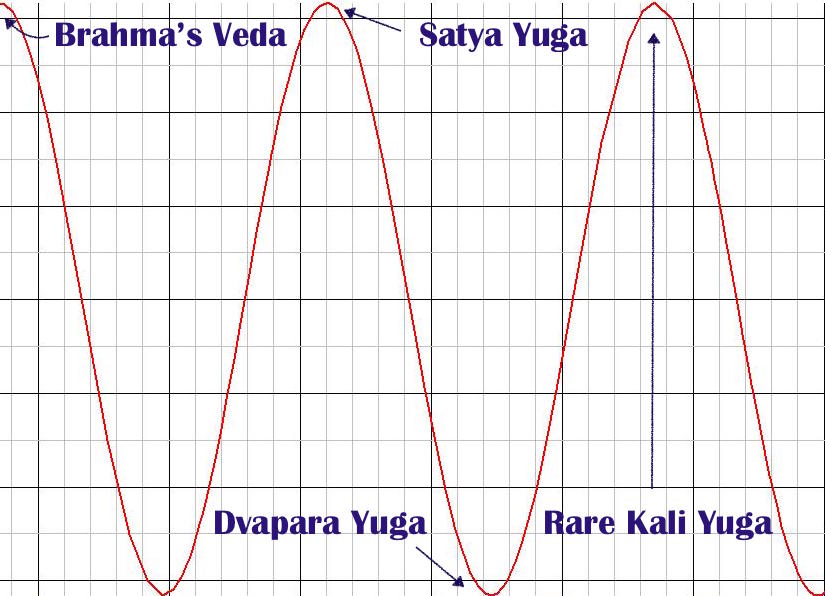In modern academic scholarship, almost every interpretation of anything relating to the classical and ancient history of India is based on the assumption that the culture – encapsulated in their sacred text, the Veda – has evolved over time. The Veda themselves, in the form we currently have them, also admit their chronological origin, but there is an important difference between the academic concept and the Vedic concept of this evolution.
The academic concept, following the concept prevalent in all applications of the “evolution” principle, posits that Vedic evolution began from scratch, from zero – and gradually worked itself into the condition we have it today.
The Vedic concept posits that its evolution began from completeness, then gradually devolved to almost zero, and then is rebuilt, gradually. So the vedic concept of its evolution is like a cosine wave, which begins from an apex. At the beginning of this sine wave, Viṣṇu delivered the seeds of all Veda in completeness to Brahmā, thus making Brahmā capable of being “Brahmā” and creating all the structures and systems that form the universe as we know it today.
From there, the Veda undergoes a constant, recurring cycle of devolution and evolution – in sync with the cosmic yugas. At the height of satya yuga, Brahmā’s veda is fully manifest. From there to the heart of Dvapara yuga that veda gradually becomes confusing, scattered lost, and misunderstood till almost nothing of its original essence remains. At that point someone takes the role of editor (“Vyāsa” means editor. Someone takes the role of Vyāsa in every Dvapara Yuga), and begins the task of restoring the essential meaning of the Veda. This task, according to the Veda itself (see. Bhāgavata Purāṇa 1.4), takes many centuries of work done by many different people. Thus restoring some lingering comprehension of the actual essence of the Veda.
One out of one thousand kali-yugas is very special, because Śrī Krishna himself appears as an avatāra. When this rare kali yuga occurs, Viṣṇu himself becomes Vyāsa and makes the final part of the Vedic restoration particularly special and suited to support Krishna’s avatar. This special evolution is the Śrīmad Bhāgavatam.
– Vraja Kishor dās


So would you say that upon return to apex the wave is on the exact same level as the previous apex? Or would the each apex be “perfect”, “more perfect” , “even more perfect”, “most perfect” and so on, where each time the apex is realized it’s even more fresh and rich than before?
Also, this down slope seems like the exact same concept as when Krishna leaves the gopis. It’s in this separation from the apex that the love intensifies until eventual reunion. But most often the down slope is framed as something negative and compared to a disease instead of a lover’s broken heart.
LikeLike
Most of the times the kaliyuga up-slope doesn’t come close to being as high as the satya yuga slope (in my opinion), but in this rare kaliyuga when there is Śrīmad Bhāgavatam followed by Śrī Caitanya’s Goswami’s commentaries and expansions, then the wave actually goes much HIGHER than the original apex.
There’s no cumulative effect, in my opinion.
LikeLike